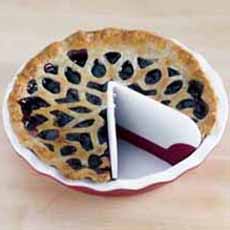|
Fruit pies are one of the joys of summer. But once you cut into your beautiful pie, the juice and fruit can spill out of the crust and into the space of the piece of pie you’ve just removed.
Unhappily called a lava flow, pan puddle or slump—or simply runny pie—you can eliminate it through experimentation with types and amounts of thickeners.
You want your pie filling to hold its shape. Where do you begin? Here’s a detailed matrix from P.J. Hamel of King Arthur Flour, who advises that every recipe needs testing until it meets your satisfaction. There is no one perfect solution.
Why? Each fruit has a different amount of pectin, a natural thickener. Each type of added thickener has a different thickening power, based on the percentage of starch it contains.
For this reason, recipes from reliable sources use a specific type and amount of thickener for a specific type of fruit. Don’t substitute either the fruit or the thickener and expect optimal results.
For example:
Apples contain a lot of pectin, a natural thickener. Although they release juice when cooked, they are not nearly as juicy as stone fruit or berries.
Stone fruits have less pectin than apples, but more than berries. They need an in-between amount of thickener.
Berries are the juiciest, and need the most thickener. Frozen berries release even more liquid, and require more thickener.
Blueberries have the most pectin of the berry group. They need a bit little less thickener than other berries.
Fresh cherries need less thickener than canned or frozen cherries.
That being said, we’re just talking runniness. Even a runny pie will still taste good.
FRUIT PIE THICKENERS
Pie thickeners prevent the valuable juices from running out when the pie is sliced.
The following thickeners are listed in order from least thickening agent, with the least amount of starch, to the strongest, starchiest thickener. (The thickening power is known as gel strength among professionals.)
All-purpose flour. The standby for generations past, flour produces a somewhat cloudy filling. Plus, you need to use more of it than you would higher-starch thickeners.
Quick-cooking/instant tapioca. makes filling bright and clear, but also gives it a stippled (and for some, “gluey”) texture. Filling mixed with tapioca needs to rest 15 to 30 minutes before baking, for the tapioca to soften.
Instant ClearJel is a product available from King Arthur Flour, that keeps fillings thick through a broad range of temperatures. This makes it ideal for pies that will be frozen, either before or after baking.
Pie Filling Enhancer, another product available from King Arthur Flour, thickens fruit pie fillings the same way Instant ClearJel does. Its advantage is added ascorbic acid (a flavor enhancer), and superfine sugar, which prevents it from clumping. Pie Filling Enhancer is about half sugar; so you’ll want to reduce the sugar in your recipe as directed below. It’s OU kosher.
|
|



[1] A blackberry pie, properly thickened, holds its shape. Here’s the recipe from The Baker Chick. [2] A great thickener for frozen pies: Instant ClearJel (photo courtesy King Arthur Flour). [3] Another solution: a pie sealer or pie gate (photo courtesy Progressive International).
|
|
Cornstarch, like flour, gives a cloudy, semi-transparent look to filling. It can also give filling a chalky or floury taste. When using cornstarch, make sure the pie filling is bubbling up through the crust before removing your pie from the oven.
A note: Our mom used cornstarch in her renowned apple and blueberry pies. No one ever noticed any cloudiness, and her pies were always in demand.
MORE TIPS TO THICKEN THE JUICES
Reduce the juice. After you sugar the berries, let them sit for 20 minutes or so, until juice starts to collect in the bottom of the bowl. Drain the juice into a pan, reduce it, and add it back to the berries.
Use a top crust with openings, such as lattice (photo #1) or cut-outs (photo #3). These allow some of the moisture in the juice to evaporate, thickening the filling. When baking a lattice or open-top pie, reduce the thickener by 1/4 teaspoon per cup of filling.
Golden crust and bubbling fruit does not mean the pie is finished. It may still need another 5 to 10 minutes to fully activate the thickener. This is especially true if flour or cornstarch are used.
Some fruit fillings will continue to thicken for 24 hours after baking. Instant ClearJel will increase the thickeners by about 15% from day 1 to day 2; quick-cooking tapioca and Pie Filling Enhancer, about 30%. Fillings thickened with flour or cornstarch will not thicken further.
|





